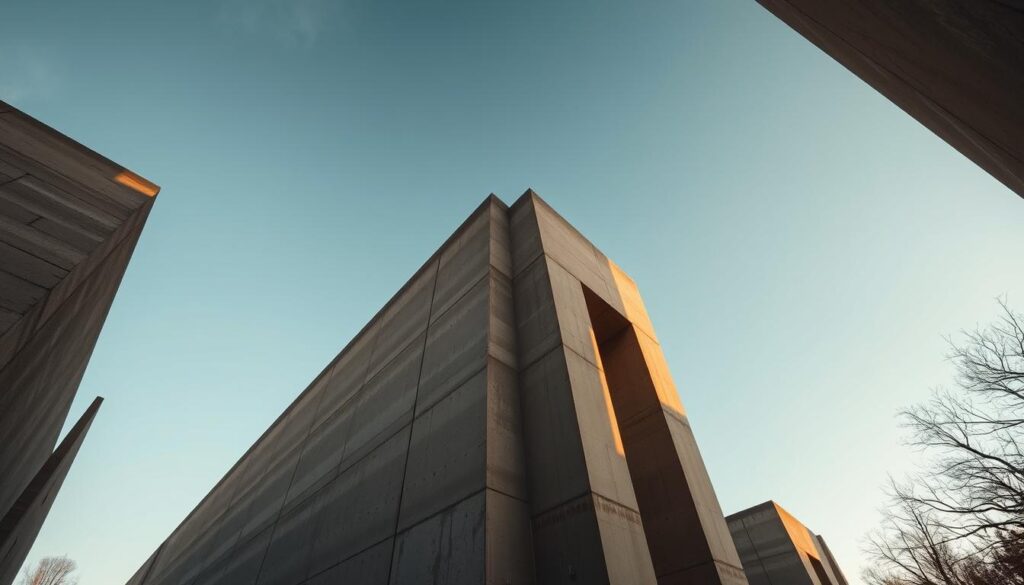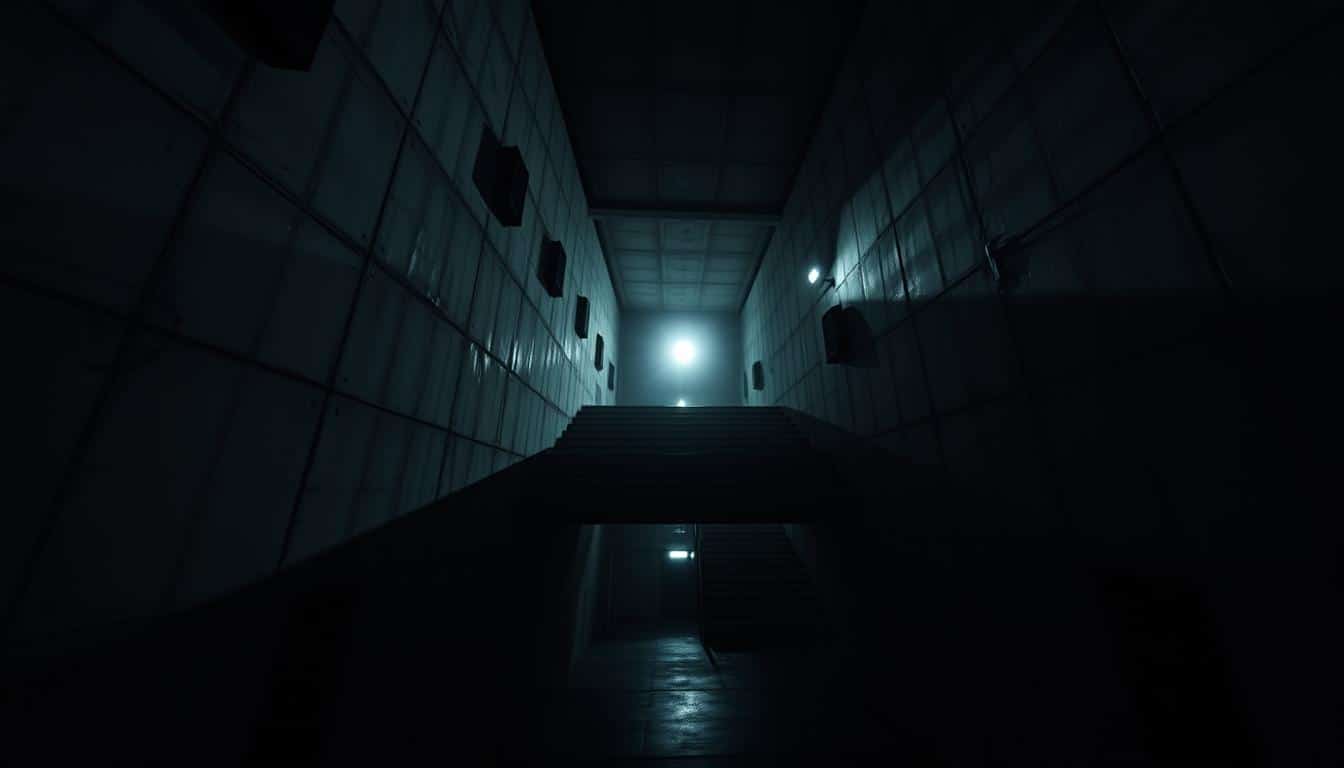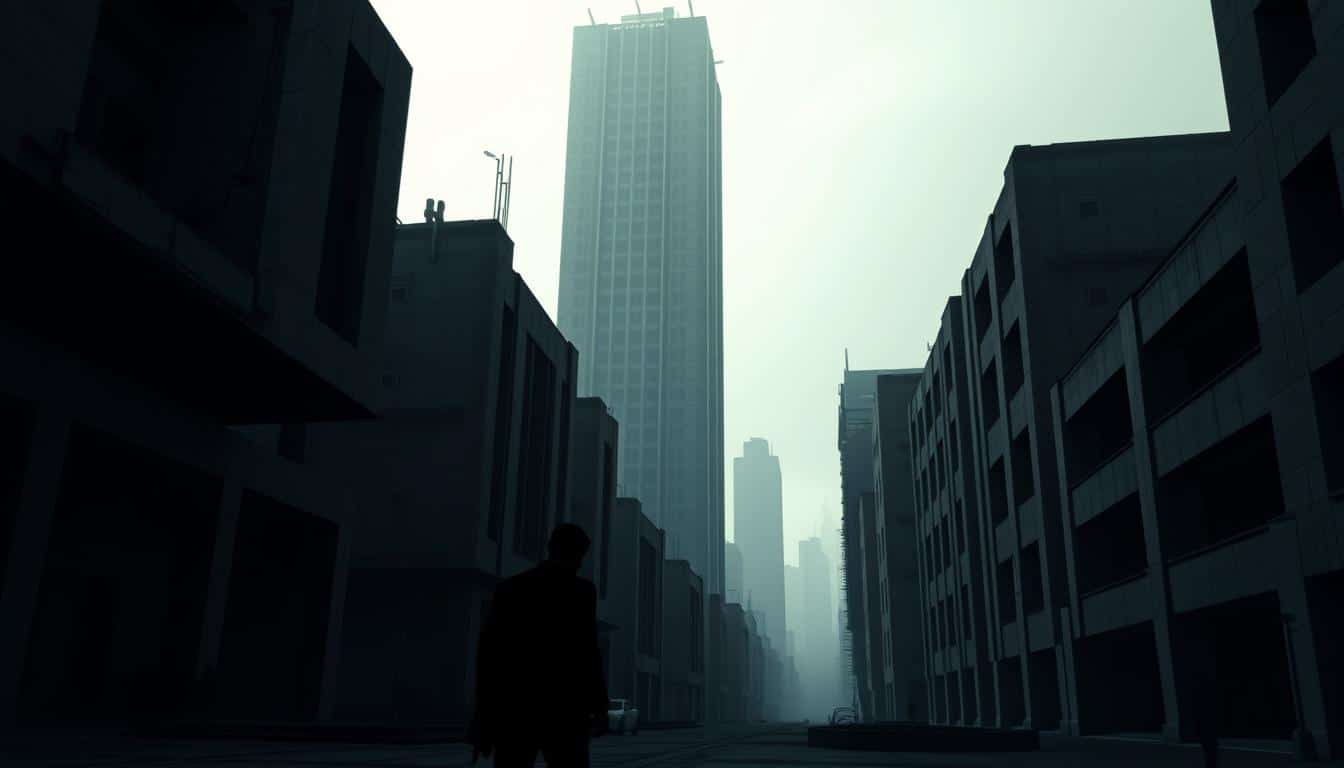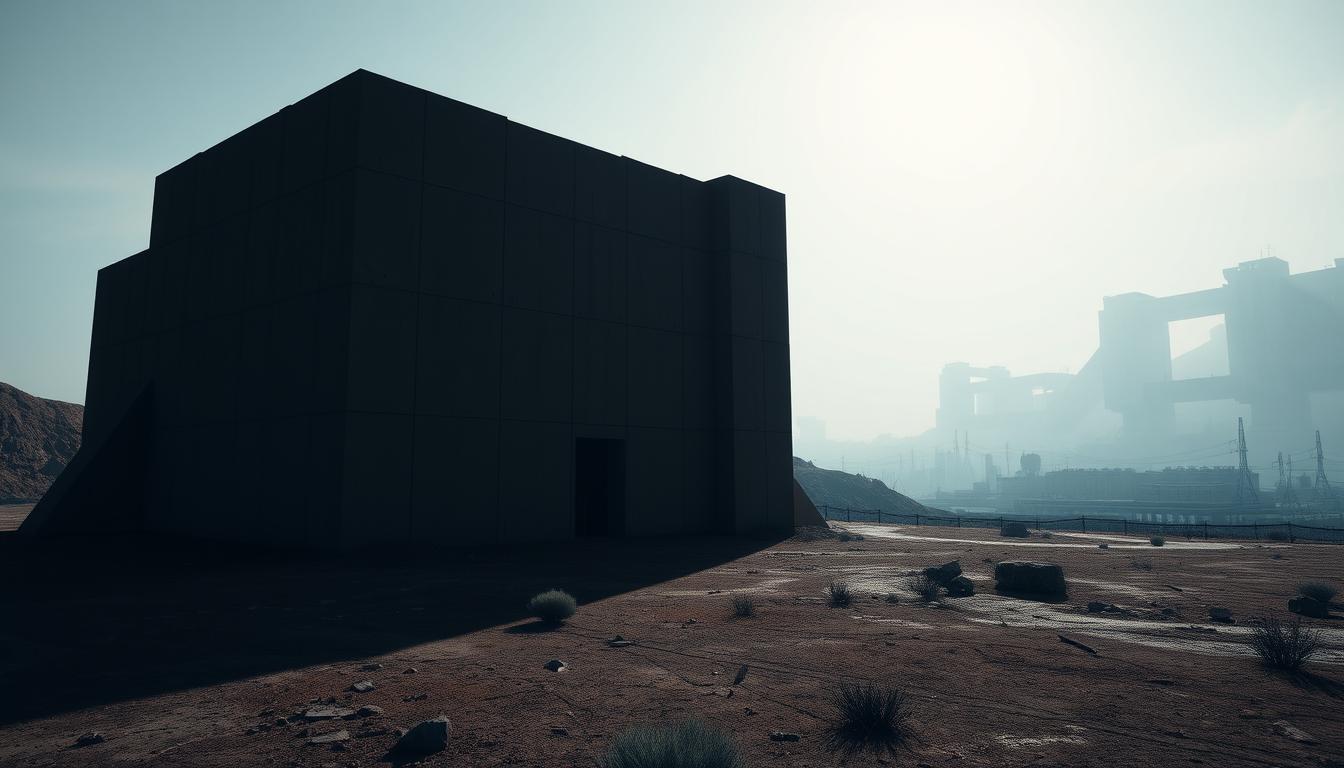Brutalist architecture is known for its raw concrete and big, bold structures. It’s key in creating tension in video games. This style makes an atmosphere that deeply affects how players feel. It adds to the game’s mood with its heavy materials and sharp shapes.
As players move through these tough environments, they see strong stories told through the buildings. Each part of the environment helps build a feeling of nervousness and excitement. By looking into how brutalism impacts game design, we discover how it brings out special emotional reactions. This allows for a deeper understanding of this unique look.
The Essence of Brutalist Architecture
Brutalist architecture is a bold response to changing times and needs, focusing on simplicity and function. It started in the late 1940s, after World War II, to help rebuild cities. The style is known for its big, bold forms, lots of exposed concrete, and a lack of decoration. These features show a shift toward using design that serves a purpose, especially after the war’s destruction.
Defining Features of Brutalism
The main traits of brutalism are clear in its unique look. Key elements include:
- Exposed concrete and raw materials that give a strong, unfinished vibe
- Geometric shapes and big structures that stand out
- Designs focused on being useful, not just pretty
Historical Context and Emergence
Brutalism’s story is deeply tied to rebuilding after the war. Architects like Le Corbusier led the way with famous buildings, choosing a style that shows off the beauty in bare materials. This style came about when there was a huge need to quickly fix up cities. It went against earlier design ideas, making a lasting impact on our buildings and how we see spaces around us.

Brutalism in Video Games
Brutalism has made a special place for itself in gaming. It has greatly shaped the look and feel of some well-loved games. Games like Quake, Halo, and Control use brutalism’s bold, raw style to make worlds that deeply connect with players. This architectural style plays a key role in impacting both gameplay and story experiences.
Notable Games Incorporating Brutalism
Some games really stand out for adding brutalist architecture into their worlds. This adds a lot to the player’s experience. Games like Quake, Halo, and Control show how strong design can tell a story and add depth to the theme:
- Quake features stark, angular structures that amplify its fast-paced gameplay.
- Halo utilizes vast, imposing designs that evoke a sense of scale and domination.
- Control presents a modern twist on brutalism, using architecture to explore themes of authority and control.
The Appeal of Rugged Aesthetics
Players are often attracted to the strong looks of these game environments. Brutalism’s sharp concrete and distinct lines can spark deep emotional responses. This makes the gameplay more powerful. The mix of striking design and captivating gameplay creates unforgettable gaming moments.
Creating Tension Through Brutalist Architecture in Gaming
Brutalist architecture is key in making games more engaging. It creates tension. This design style can make players feel more involved by triggering strong emotions. Things like large concrete structures and simple forms can make players feel anxious or uneasy.
Emotional Responses Evoked by Design
The simplicity of brutalist environments can cause intense feelings in players. They might feel:
- Trapped by big concrete walls.
- Exposed in huge, empty areas.
- Deep thoughts due to the harsh, simple looks.
This design makes players really think about their surroundings. They become more drawn into the game’s story and feelings. Brutalism in games creates a space that’s perfect for both exploring and thinking deeply. It makes players face their fears and doubts.
Architectural Characteristics That Amplify Tension
Certain aspects of brutalist architecture build up tension in games. These include:
- Huge buildings that overshadow players.
- Repeating patterns that feel endless.
- Harsh materials that suggest emptiness.
As players move through these stark scenes, the design makes them think and feel more. This deepens their game experience and their bond with the game world.
The Influence of Environment on Gameplay
Gameplay deeply connects with architectural design, especially through brutalist environments. How areas are built and organized can make moving around easy or hard. Different spatial layouts lead players and stir different feelings when in open versus tight spaces.
Spatial Design and Player Navigation
Spatial design is key to keeping players engaged in games. A well-planned space makes it easy for players to move, explore, and interact. This leads to a more enjoyable experience.
Open areas give players a freedom that encourages trying new things. Tight spaces, on the other hand, make gameplay more challenging and require smart tactics. These differences show how the design influences how players act and make decisions.
Psychological Effects of Open vs. Confined Spaces
Architectural choices play a big role in how players feel during a game. Open areas can make players feel safe, leading them to explore more. Tight, cramped spaces can make players anxious, forcing them to think hard about their next move.
This connection between space and emotion is crucial. It shows the power of design in changing how players react and feel. This mix keeps the game exciting and keeps players hooked on the story.
Key Examples of Brutalist Architecture in Gaming
Brutalist architecture often appears in gaming, creating worlds that stir strong feelings in players. Games like NaissanceE and Control show how architecture impacts interactive media. These games stand out for their architectural styles.
NaissanceE: A Case Study
In NaissanceE, brutalist elements are a core part of the game. Players explore strange, yet stunning settings made of raw architectural designs. This design creates a distinct atmosphere, highlighting brutalism’s bare contrasts and simple beauty. It makes the game more immersive for players.
Control and the Oldest House
Control uses brutalist architecture in the setting of the Oldest House. This building is almost a character itself, bringing out feelings of power and isolation. Its architectural style adds to the game’s visual and thematic richness. These examples show how brutalist beauty enhances game stories and gameplay, affecting players deeply.
The Role of Soundscapes in Enhancing Tension
Soundscapes are key in making games feel more intense. In brutalist settings, how sound is designed affects how much players get into the game and their feelings. The big, strong materials in these places create a unique sound. This makes the game feel more tense.
Acoustic Design in Brutalist Settings
Brutalist buildings have hard surfaces and big spaces that carry sound well. They create complex sound environments. Here are the key parts:
- Hard surfaces bounce sound back, making audio cues clearer.
- Big spaces create special echo effects, making soundscapes deeper.
- Sounds from game elements mix naturally with building spaces, keeping players more engaged.
These features help make sound feel more real. They let players sense the heaviness of their surroundings and make the game more tense.
Sound Interaction with Architecture
Sound and brutalist architecture work together to make the game feel more intense. Players might notice:
- Sounds from the environment that warn of dangers or give hints, creating suspense.
- Sounds change as players move around, changing how they see the space.
- Background noises that increase tension and connect players emotionally to the game’s story.
This smart use of soundscapes makes the game more fun and improves the story. It lets players fully dive into the eerie beauty and deep psychological feel of brutalist settings.
Immersion and Exploration in Brutalist Worlds
Brutalist architecture deeply draws players into video games. This design creates liminal spaces which feel like transitions. These places make players want to explore more. Each area is a call to uncover secrets and understand their story.
Creating Liminal Spaces
Liminal spaces have a bare yet intriguing look. They make players feel both curious and uneasy. This mix of feelings makes gamers think deeply about their virtual surroundings. It adds depth to their gaming experience.
The Interplay of Light and Shadow
Light and shadow are very important in brutalist games. They highlight architecture and add mystery with shadows. This makes the game world more immersive as players have to deal with changing visibility.
Modern Interpretations of Brutalism in Game Design
The world of modern game design is changing. More independent developers are getting attracted to the stark, powerful look of brutalist architecture. They use this style to make games that are not just about playing, but also about feeling and exploring. This shift is making games more deep and emotionally engaging.
New Trends and Innovations
Brutalism in gaming is all about new ideas:
- Simple graphics that focus more on shape than decoration.
- Real textures and materials bring a sense of truth.
- Bold lighting contrasts make the game feel more real.
- Huge, open spaces that make players think creatively.
Independent Developers and Brutalist Inspirations
Indie developers are key to this trend. They use brutalist ideas to make games that stand out. They value creativity over following trends, leading to:
- Unique visual styles unlike anything in big games.
- Gameplay that rewards trying new things and exploring.
- Stories that blend with the game’s brutalist buildings and spaces.
Exploring brutalism helps spark new kinds of creativity. It makes players see game worlds in new ways. As we keep talking about design in games, looking closely at these trends can reveal a lot about where games are headed.
Criticism of Brutalist Structures in Gaming
Brutalist architecture in games often gets criticized for its bold and cold look. This style really divides players. Some love the boldness, but others feel it makes things too gloomy and lonely. This raises big questions about how these designs affect us.
The Dichotomy of Dread and Awe
Brutalist scenes in games make players feel many things. They might feel:
- Dread: The no-nonsense style can make players uneasy, feeling cut off.
- Awe: The big, simple designs can also make players admire the bravery of the style.
This mix of feelings creates an interesting challenge. Players have to deal with their inner reactions as they play. Some people think these strong reactions make games more immersive. Others don’t.
Debates Surrounding Aesthetics and Humanity
Many people talk about how brutalist game designs might make things less human. They worry it makes games feel colder. They talk about:
- The mental effect of being in places that don’t feel welcoming.
- How this stark style influences how players connect with the story.
- If brutalism’s look can either tell a story better or push players away.
The debate on how brutalism affects gaming and stories continues. It’s key to understanding its impact on how players experience games.
Lessons Drawn from Real-World Brutalism
Brutalist architecture tells us a lot about the cities we live in. It shows how style can reflect big societal issues, affecting how people come together or feel isolated. Looking at brutalism helps us see how these ideas might work in video games too.
Socio-Political Underpinnings of the Style
Brutalism was born in a time of big changes in society. Designers wanted their buildings to mirror these shifts, using simple materials and designs. This wasn’t just about how things looked. It was about meeting the community’s needs.
The ideas behind brutalism stressed making places that bring people together. These principles can teach us a lot about building engaging stories in games.
Brutalism’s Impact on Urban Space
In cities, brutalist buildings stand out, sparking debate among the people who see them every day. They challenge us to think about whether our public spaces are welcoming or intimidating. This conversation is key to understanding how architecture affects us.
By studying brutalism, game designers can learn how to create game worlds that feel real and engaging. It shows how paying attention to the environment can make stories more immersive.
Conclusion
We’ve seen the big role brutalist architecture plays in making games more engaging. This style isn’t just for looks. It makes us feel tense and involved. The way games are designed can change how we see and move in them.
Brutalism isn’t just a style; it’s a game-changer. Its bold looks and simple shapes do more than decorate. They connect us deeper with the game’s world. These designs make us think and feel different emotions, which is key for future games.
Looking forward, brutalism’s effects in games are still strong. It shows us that buildings can tell stories too. Game makers use this style to mix beauty with storytelling. This keeps brutalism important as gaming grows.



